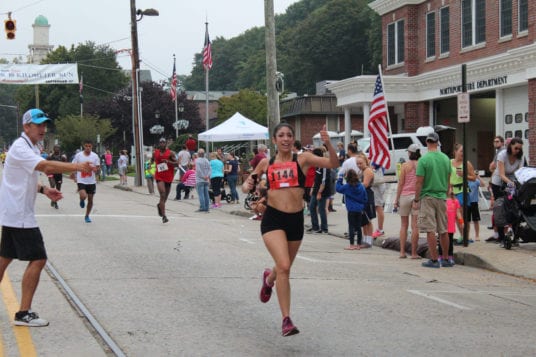A familiar runner jogging along Stony Brook roads stands out from the others.
“My claim to fame is that I’m still running at 85,” Steven Fuchs said.
The Stony Brook resident said he has been running for more than 40 years, and earlier this year he traveled to Atlanta, Georgia, for the USATF 2022 Masters 5 Km Championships, where he placed first in the men’s 85-and-over category, finishing the race in 45 minutes, 31 seconds.
He was modest about the win.
“I was very excited about it,” he said. “It was great fun, but there’s not many people running anymore at my age.”
His daughter Dorothy O’Brien on the other hand was impressed.
“It’s pretty amazing,” she said. “I think it’s inspiring.”
Fuchs said runners who register trace their running history to find out what times they have achieved in past races. The grandfather of five said he believes this deters some from the national race because they aren’t inspired to travel when they see others signed up who have run faster in other races. However, he said it’s always fun to travel, get together with fellow runners and talk about their love of the sport.
Fuchs said when he was younger he was always competitive, and he recommended the sport as well as the races to others.
“It’s great exercise, and I enjoy it,” he said. “People who are runners are wonderful people.”
Not one to slow down, Fuchs is still involved in real estate investment, which has been his decades-long career.
To keep moving, he said, “is a great lesson in life.” And his advice is to “pick an activity that you can continue with.”
In the past, he played tennis but had problems with one of his shoulders, and he said he’s been lucky that his knees have held up so he can continue to run, which he attributes to finding the right pair of running shoes.
“What I like particularly about running is that I don’t have to get a foursome together to play golf, or I don’t have to get a partner to play doubles in tennis,” he said. “I just put on my sneakers at 2 or 3 in the afternoon and run all by myself.”
He tries to do so daily to West Meadow Beach and back home, and is no stranger to the local races. His first race was one in the 1970s that started at Emma S. Clark Memorial Library. Through the decades, he has participated in local races, including Soles for All Souls organized by All Souls Episcopal Church in Stony Brook, the Smithtown Running of the Bull, Lt. Michael P. Murphy Run Around the Lake in Ronkonkoma as well as several in Sayville.
While he sticks now to 5K races, when he was younger he said he ran longer ones, including the 10K, which is approximately 6.2 miles, and half marathons.
“As I get older, the distances tend to get shorter,” the runner said.
He’s learned with training that a runner has to take it easy at times.
“You can’t knock your brains out every time you go out to train,” Fuchs said. “I just jog around very slowly, and where I put my effort is the day of the race. That’s my real work day.”
His secrets to keeping fit through the years include running and eating right. He also doesn’t smoke or drink alcohol.
“For me it has worked,” he said. “I’m lucky.”
He recommends running for those looking to stay in shape and his advice is to get the right shoes.
“You’re not necessarily in competition all the time,” he said. “You can go at your own pace. You can do it when you want to do it.”
Fuchs recommends the races as a good opportunity to get together with those who share the same interest, and he plans to travel to the national championships in 2023.
“I fully expect to be back again next year,” he said.




















































